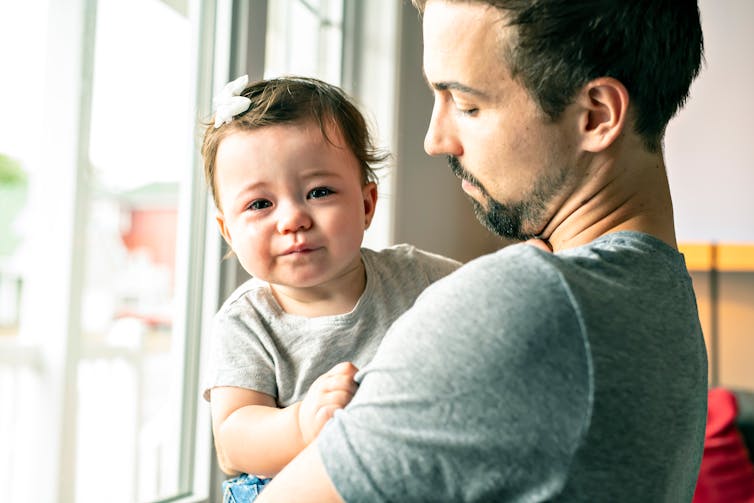
NinaViktoria/Shutterstock
Karleen Gribble, Western Sydney University and Nina J Berry, University of Sydney
Thousands of families with babies and toddlers have been affected by Australia’s bushfire disaster. This includes children whose homes have been under direct threat or impacted by severe smoke pollution, or where their parents volunteer or work as fire fighters.
Babies and toddlers may not be aware of the danger the fires pose to them or their families. But they find changes in their environment distressing and may notice the stress of their caregivers.
Routine and predictability makes young children feel safe. Evacuating, travelling long distances, noisy evacuation centres and staying in crowded or temporary accommodation disrupts this predictability.
Read more:
Bushfires can make kids scared and anxious: here are 5 steps to help them cope
Kids communicate with behaviour, not just words
Babies and toddlers can’t easily communicate they’re unsettled with words so they show it in their behaviour. This might include:
-
babies feeding more frequently and being unsettled during feeds
-
toddlers wanting to eat more or not wanting to eat at all
-
wanting to be held more and and showing increased clinginess
-
difficulty in going to sleep and waking more frequently during day and night sleeps
-
regressions in learnt behaviours such as sitting, crawling and walking
-
being whingey and wanting more attention, or being easily distressed or withdrawn.

Lopolo/Shutterstock
When parents are stressed, they find it more difficult to notice their baby’s or toddler’s behavioural communications.
In the acute phase of an emergency, it may not be possible to respond to a baby or toddler. Very young children can find this extremely stressful.
Read more:
After the firestorm: the health implications of returning to a bushfire zone
How to help your child cope
If your baby or toddler is showing signs of distress, provide them with responsive care. This involves watching and noticing their behavioural cues, including body movements and sounds, and responding to this communication in a nurturing way.
The behavioural changes you see in your child provide you with information about what they need.
A baby or toddler who doesn’t want to go to anyone but their mother is communicating that, right now, mum represents safety and only mum will do.
A child who is waking at night is saying, “I’m scared. I need you near to reassure me when I wake.”
A child who is demanding or withdrawn is indicating they need more attention, not less.

Hananeko_Studio/Shutterstock
Try not to worry too much about feeding issues. Allow babies and toddlers to eat when they indicate hunger. Offer food frequently but don’t try force your toddler to eat.
Keeping your baby or toddler physically close will help you to notice their cues and provide responsive care. Baby slings can help parents do this while they get on with other things.
Consider delaying any changes that you were considering before the fires, such as starting solid foods, introducing a bottle, giving up the dummy, starting childcare or moving the child out of your bedroom. When things have settled down again, your baby or toddler should once again be able to manage these changes.
If you feel you’re struggling to provide responsive care to your baby or toddler, ask your family or friends for extra help or contact your child health nurse or doctor.
Breastfeeding mothers – stress won’t reduce your supply
Changes in babies’ feeding and sleeping behaviour during emergencies can be particularly concerning to breastfeeding mothers who worry the stress will affect their milk supply.
Research tells us stress has no impact on milk production. But it can slow the release of milk, making babies fussy at the breast.
Read more:
Evacuating with a baby? Here’s what to put in your emergency kit
If this happens, keep offering breastfeeds. While feeding, focus on your baby and think about how much you love them. This will release hormones that make the milk flow and help you and your baby to feel more relaxed.
We all need to support parents through this disaster
Helping babies and toddlers to recover from an emergency shouldn’t just be left to parents. Those around families with babies and toddlers can help by cleaning or cooking, allowing parents to prioritise caring for their children and other pressing tasks.
The impact of an emergency can persist for some time. If you feel you’re still affected by the disaster, your baby or toddler might feel that too. Give them and yourself time. Babies and toddlers usually recover well after emergencies. Your love and responsive care is the key.![]()
Karleen Gribble, Adjunct Associate Professor, School of Nursing and Midwifery, Western Sydney University and Nina J Berry, Post-doctoral Research Associate, Sydney School of Public Health, University of Sydney
This article is republished from The Conversation under a Creative Commons license. Read the original article.
